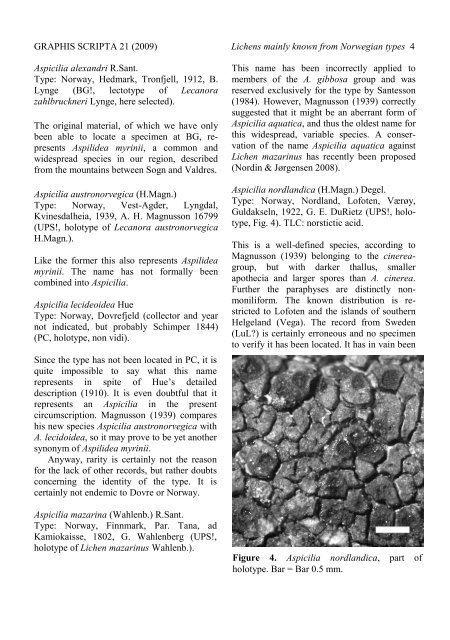(2009): Lichens in Scandinavia known mainly from Norwegian type ...
(2009): Lichens in Scandinavia known mainly from Norwegian type ...
(2009): Lichens in Scandinavia known mainly from Norwegian type ...
You also want an ePaper? Increase the reach of your titles
YUMPU automatically turns print PDFs into web optimized ePapers that Google loves.
GRAPHIS SCRIPTA 21 (<strong>2009</strong>) <strong>Lichens</strong> ma<strong>in</strong>ly <strong>known</strong> <strong>from</strong> <strong>Norwegian</strong> <strong>type</strong>s 4<br />
Aspicilia alexandri R.Sant.<br />
Type: Norway, Hedmark, Tronfjell, 1912, B.<br />
Lynge (BG!, lecto<strong>type</strong> of Lecanora<br />
zahlbruckneri Lynge, here selected).<br />
The orig<strong>in</strong>al material, of which we have only<br />
been able to locate a specimen at BG, represents<br />
Aspilidea myr<strong>in</strong>ii, a common and<br />
widespread species <strong>in</strong> our region, described<br />
<strong>from</strong> the mounta<strong>in</strong>s between Sogn and Valdres.<br />
Aspicilia austronorvegica (H.Magn.)<br />
Type: Norway, Vest-Agder, Lyngdal,<br />
Kv<strong>in</strong>esdalheia, 1939, A. H. Magnusson 16799<br />
(UPS!, holo<strong>type</strong> of Lecanora austronorvegica<br />
H.Magn.).<br />
Like the former this also represents Aspilidea<br />
myr<strong>in</strong>ii. The name has not formally been<br />
comb<strong>in</strong>ed <strong>in</strong>to Aspicilia.<br />
Aspicilia lecideoidea Hue<br />
Type: Norway, Dovrefjeld (collector and year<br />
not <strong>in</strong>dicated, but probably Schimper 1844)<br />
(PC, holo<strong>type</strong>, non vidi).<br />
S<strong>in</strong>ce the <strong>type</strong> has not been located <strong>in</strong> PC, it is<br />
quite impossible to say what this name<br />
represents <strong>in</strong> spite of Hue’s detailed<br />
description (1910). It is even doubtful that it<br />
represents an Aspicilia <strong>in</strong> the present<br />
circumscription. Magnusson (1939) compares<br />
his new species Aspicilia austronorvegica with<br />
A. lecidoidea, so it may prove to be yet another<br />
synonym of Aspilidea myr<strong>in</strong>ii.<br />
Anyway, rarity is certa<strong>in</strong>ly not the reason<br />
for the lack of other records, but rather doubts<br />
concern<strong>in</strong>g the identity of the <strong>type</strong>. It is<br />
certa<strong>in</strong>ly not endemic to Dovre or Norway.<br />
Aspicilia mazar<strong>in</strong>a (Wahlenb.) R.Sant.<br />
Type: Norway, F<strong>in</strong>nmark, Par. Tana, ad<br />
Kamiokaisse, 1802, G. Wahlenberg (UPS!,<br />
holo<strong>type</strong> of Lichen mazar<strong>in</strong>us Wahlenb.).<br />
This name has been <strong>in</strong>correctly applied to<br />
members of the A. gibbosa group and was<br />
reserved exclusively for the <strong>type</strong> by Santesson<br />
(1984). However, Magnusson (1939) correctly<br />
suggested that it might be an aberrant form of<br />
Aspicilia aquatica, and thus the oldest name for<br />
this widespread, variable species. A conservation<br />
of the name Aspicilia aquatica aga<strong>in</strong>st<br />
Lichen mazar<strong>in</strong>us has recently been proposed<br />
(Nord<strong>in</strong> & Jørgensen 2008).<br />
Aspicilia nordlandica (H.Magn.) Degel.<br />
Type: Norway, Nordland, Lofoten, Værøy,<br />
Guldakseln, 1922, G. E. DuRietz (UPS!, holo<strong>type</strong>,<br />
Fig. 4). TLC: norstictic acid.<br />
This is a well-def<strong>in</strong>ed species, accord<strong>in</strong>g to<br />
Magnusson (1939) belong<strong>in</strong>g to the c<strong>in</strong>ereagroup,<br />
but with darker thallus, smaller<br />
apothecia and larger spores than A. c<strong>in</strong>erea.<br />
Further the paraphyses are dist<strong>in</strong>ctly nonmoniliform.<br />
The <strong>known</strong> distribution is restricted<br />
to Lofoten and the islands of southern<br />
Helgeland (Vega). The record <strong>from</strong> Sweden<br />
(LuL?) is certa<strong>in</strong>ly erroneous and no specimen<br />
to verify it has been located. It has <strong>in</strong> va<strong>in</strong> been<br />
Figure 4. Aspicilia nordlandica, part of<br />
holo<strong>type</strong>. Bar = Bar 0.5 mm.

















